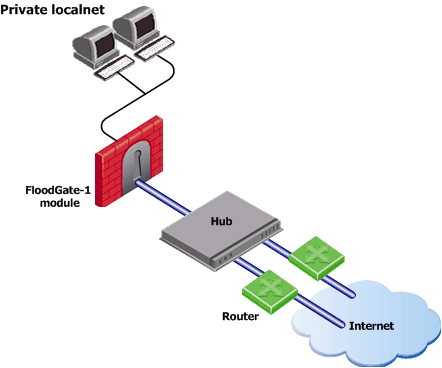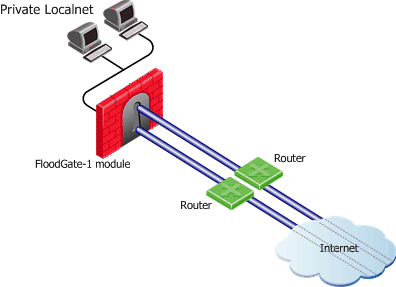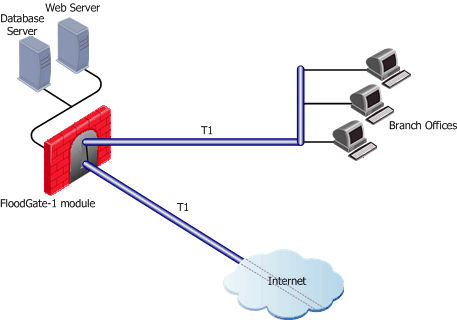Deploying QoS
Deploying QoS
QoS Topology Restrictions
QoS can manage up to the maximum number of external interfaces supported by Firewall, subject to the following restrictions. (Refer to the Firewall documentation for further information):
- All of the traffic on a managed line must go through the gateway.
- Each managed line must be connected (directly or indirectly via a router) to a separate physical interface on the QoS machine. Two managed lines may not share a physical interface to the QoS machine, nor may two lines be connected to the same router.
For example, in the configuration depicted in Figure 10‑1, the routers can pass traffic to each other through the hub without the QoS gateway being aware of the traffic.

In addition, you cannot manage two lines connected to a single router since traffic may pass from one line to the other directly through the router, without the QoS gateway being aware of the traffic:

An example of a correct configuration is:

Sample Bandwidth Allocations
Frame Relay Network

The previous diagram shows that the branch offices communicate with the central site and the opposite. They do not communicate directly with each other or with the Internet except through the central site. The Web server makes important company documents available to the branch offices, but the database server supports the company's mission-critical applications.
The problem is that most of the branch office traffic is internal and external Web traffic, and the mission-critical database traffic suffers as a result. The network administrator has considered upgrading the 56K lines, but is reluctant to do so, not only because of the cost but also because upgrading would probably not solve the problem. The upgraded lines would still be filled mostly with Web traffic.
The goals are as follows:
- Allocate the existing bandwidth so that access to the database server gets the largest share.
- Take into account that the branch offices are connected to the network by 56K lines.
These goals are accomplished with the following Rule Base:
Main Rules
|
|
|
|
|
Rule Name
|
Source
|
Destination
|
Service
|
Action
|
Office 1
|
Office 1
|
Any
|
Any
|
Weight 10
Limit 56KBps
|
|
Office n
|
Office n
|
Any
|
Any
|
Weight 10
Limit 56KBps
|
Default
|
Any
|
Any
|
Any
|
Weight 10
|
Each office has sub-rules, as follows:
Office Sub-Rules
|
|
|
|
|
Rule Name
|
Source
|
Destination
|
Service
|
Action
|
Start of Sub-Rule
|
Database Rule
|
Any
|
Database server
|
Database service
|
Weight 50
|
Web Rule
|
Any
|
Web Server
|
http
|
Weight 10
|
Branch Offices
|
Any
|
Any
|
Any
|
Weight 10
|
End of Sub Rule
|
The sub-rules give database traffic priority over Web traffic and other traffic.
Assumptions
The following assumptions are made in this example:
|

